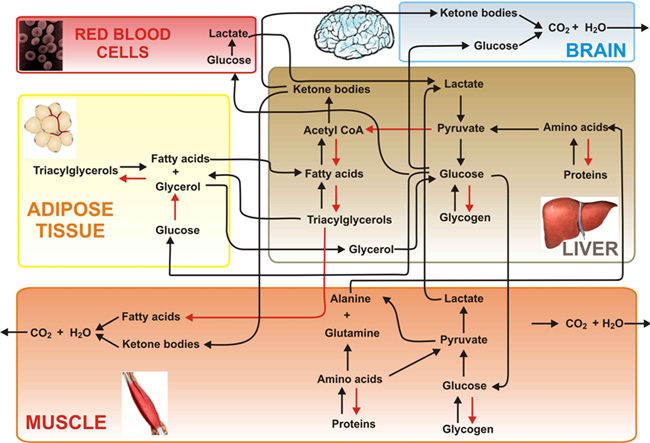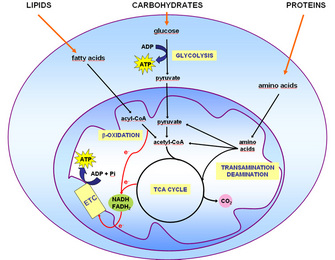Organs Which Use Glucose as Their Primary Energy Source
Neurons have the highest energy demand of all types of cells in the human body requiring continuous delivery of glucose from blood. Other vital organs and tissues in addition to the brain and skeletal muscles use glucose as their primary or sole source of energy.

Difference Between Glycogenolysis And Gluconeogenesis Definition Process Reaction Pathway Biology Lessons Study Biology Medical Laboratory Science
In addition the blood.

. The cornea lens and retina of the eyes as well as red and white blood cells are examples of other tissues and organs. Brain tissue relies almost exclusively on glucose as its source of energy. In the adult brain neurons have the highest energy demand 1 requiring continuous delivery of glucose from blood.
However there are select organs that play a crucial role in glucose regulation. Heart and kidneys have other ways too to derive their. Many tissues can also use fat or protein as an energy source but others such as the brain and red blood cells can only use glucose.
The liver is an important storage site for glycogen. Adipose muscle and liver cells are the primary sites of energy storage. Approximately 25 of circulating blood glucose and 20 of consumed oxygen is utilized by the brain an organ that constitutes less than 2 of the human body mass 1.
In humans the brain accounts for 2 of the body weight but it consumes 20 of glucose-derived energy making it the main consumer of glucose 56 mg glucose per 100 g. Organ Systems Involved. However during cardiac failure the heart can switch to glucose utilization.
Glucose is the primary fuel for the brain but if glucose is low the brain can switch to ketone bodies to replace about 20 of its glucose requirement. What organs can only use glucose. Gluconeogenesis is particularly essential during fasting and starvation because the erythrocytes kidney lens and cornea depend on glucose as their sole energy source.
The liver is an important storage site for glycogen. Glucose The body and brain use glucose as their primary energy source. Organs or tissues where gluconeogenesis takes place.
The glucose in the blood is therefore stored in liver and muscle cells in the form of a larger molecule called glycogen. The organ which uses glucose as its primary souce of metabolic fuel is brain. Glucose is stored in the body as glycogen.
Glucose is stored in the body as glycogen. Cells break down glucose to create ATP a molecule that cells use as energy. This can be attributed to the fact that brain cannot store glucose for its energy needs and purposes and hence needs a continuous supply of glucose.
Muscle stores glucose as glycogen 400g that can be quickly converted back to glucose for muscle activity. The body is able to detect blood glucose levels via an organ called the pancreas. Organs or tissues where gluconeogenesis takes place.
After food is digested glucose is released into the bloodstream. Glycogen phosphorylase is the primary enzyme of glycogen breakdown into glucose. Most common precursors for glucose biosynthesis b.
In response the pancreas secretes insulin which directs the muscle and fat cells to take in glucose. Cells obtain energy from glucose or convert it to fat for long-term storage. D Glucose is synthesized by gluconeogenesis and glycolysis and is spared for use by the nervous system.
Glucose a simple sugar provides energy for cell functions. The brain uses blood glucose as its major energy source. However both processes are always occurring at some level in the body because glucose is important for producing energy.
More specifically it is detected. Adipose can use glucose to synthesize fatty acids and triglycerides. Adult hearts use free fatty acids which are less efficient require more O_2 to synthesize the same amount of ATP.
The production of glucose from other metabolites is necessary for use as a fuel source by the brain testes erythrocytes and kidney medulla since glucose is the sole energy source for these organs. C Glucose is stored as glycogen and is the primary energy source for all body cells. Which organ depends almost exclusively on glucose as an energy source.
Proteins are made up of amino acids and are required for cell and tissue growth maintenance and repair. Glucose has a vital role in every organ system. The liver favors glycogen as its primary source since it is efficiently broken down into glucose in a process known as glycogenolysis.
Glucose metabolism provides the fuel for physiological brain function through the generation of ATP the foundation for neuronal and non-neuronal cellular. B Glucose is synthesized by gluconeogenesis and glycolysis and is the primary energy source for all body cells. Organs which use glucose as their primary energy source c.
Some organs preferentially use one energy source more than the others so that each energy source is spared for organs with strict energy needs. The human brain depends on glucose as its main source of energy. Under fasting conditions blood glucose is supplied primarily by the liver through glycogenolysis and gluconeogenesis.
Adipose serves as practically unlimited long term storage for energy dense lipids. Glucose a monosaccharide is the primary source of energy for the brain as well as for the body during moderate-to-intense physical activity. Glucose derived from liver glycogen is the primary source of blood glucose used by the rest of the body for fuel.
Which of the following is glucose most critical as an energy source. The liver is an important organ with regards to maintaining appropriate blood glucose levels. Glucose travels through the bloodstream and organs with glucose transporters on their cells take up glucose.
For brain also glucose is virtually the sole fuel for the human brain except during prolonged starvation where they require ketone bodies for energy. Fetal hearts use glucose as their primary metabolic substrate. Glucose enters cells through glucose transporters.
The mammalian brain depends on glucose as its main source of energy. Organs which use glucose as their primary energy source c. Organs such as testes red blood cells kidneys and parts of the eye such as the retina use glucose as their sole energy source and other parts of the body also have a high demand for glucose such as the brain and muscles.
In this process the liver breaks the bonds that hold glucose molecules together as glycogen degrading. The brain lacks fuel stores and hence requires a continuous supply of glucose.

Nutrient Metabolism Human Learn Science At Scitable

Pin On Diabetic Profile Package
Which Organ Stores Glucose In The Body Quora

Insulin Is A Major Regulator Of Metabolism And Organ Function Download Scientific Diagram

Image Explains The Process Of Glycogen Synthesis Biochemistry Body Organs Muscle Tissue

Nutrient Metabolism Human Learn Science At Scitable

Main Organs Involved In Glucose Metabolism Intechopen
Roles Of Ppars In The Energy Metabolism Of Various Organs The Three Download Scientific Diagram

Major Metabolic Functions Of The Liver During The Fed State Glucose Download Scientific Diagram

Photosynthesis Review Board Game Guide 2021 Photosynthesis Game Guide Review Board

Nutrient Metabolism Human Learn Science At Scitable

Pin By Teresita Ballesteros On Health In 2021 Nutrition Labels Natural Detox Drinks Nutrition Tips







Comments
Post a Comment